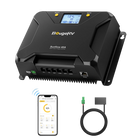How Many Times Can You Claim The Solar Tax Credit?


The solar tax credit is undoubtedly a topic that's piqued the interest of many homeowners and environmentally conscious individuals. As someone who has delved into the world of renewable energy incentives, we’re here to shed light on a question that often crosses our minds: How many times can you claim the solar tax credit?
Here's the deal: The ITC had a limit of one-time use per installation. However, you can potentially claim the solar tax credit for multiple installations, provided they are on different properties. For instance, if you install a solar energy system on your primary residence and then decide to invest in solar for your vacation home or rental property, you could be eligible for the credit on each of these separate installations.
But there's even more to consider. Let's delve deeper into the details to uncover how the solar tax credit works and explore potential scenarios where you might want to consider its implications more closely.
What Is The Solar Tax Credit In Depth

The Solar Tax Credit's story begins in an era when renewable energy wasn't just a buzzword but a vision for a greener future. Enacted as part of the Energy Policy Act of 2005, this credit was a catalyst for change aimed at nurturing the adoption of solar power across homes and businesses.
Through its evolution, it has weathered policy shifts and emerged stronger, continuing to play a pivotal role in shaping our energy landscape. This incentive emerged as a beacon of hope for both environmental enthusiasts and those looking to trim their expenses.
How Does The Federal Solar Tax Credit Work?
The eligibility criteria for the Solar Tax Credit aren't as complex as you might think. It's not reserved solely for the greenest of eco-warriors – homeowners can bask in its benefits.
Suppose you've invested in solar panels on your primary residence or even your second home. In that case, you're potentially eligible for this credit. Remember, though; it's a one-time deal per installation. So, if you're dreaming of a solar-powered empire, each installation could be your ticket to unlocking this financial incentive.
For installations completed in tax years 2022 through 2032, the ITC is set at a generous 30%. This means that a significant portion of your solar system's cost gets knocked off, directly impacting your bottom line. Planning your solar venture? Don't forget to factor in this substantial discount that can turn your financial outlook sunnier.
Limitations And Exclusions Of The Solar Tax Credit
Some limitations and exclusions might cast a cloud over your expectations. While this incentive holds a radiant promise, it's essential to know scenarios where its reach may fall short—leasing a solar energy system and envisioning the benefits of renewable power without the initial upfront cost. Unfortunately, this scenario steps beyond the boundary of the Solar Tax Credit. The credit extends its hand only to those who own their solar installations.
While the advantages of leasing remain undeniable, it's vital to recognize that the Solar Tax Credit doesn’t play a role in this particular script. So, to secure the full extent of the Solar Tax Credit, your solar project must be completed by a specific date. This deadline is crucial in determining whether you're entitled to the credit's benefits. Falling short of this timeline might result in a dimmed credit percentage, impacting your anticipated financial benefits.
Business-Only Exclusions
While the Solar Tax Credit welcomes various players onto its stage, there's a stipulation you should be aware of if you're running a business.
Suppose your solar project is exclusively intended for business property. In that case, the credit might not encompass your scenario as it does for residential installations. This distinction emphasizes the credit's focus on encouraging residential renewable energy adoption.
How To Claim The Tax Credit For Solar Panels?
Here is the step-by-step process of claiming this enticing incentive, ensuring you easily navigate the paperwork and procedures.
1. Gather Your Solar System DetailsBefore diving into the claim process, arm yourself with the essential information. Collect all the pertinent details about your solar installation – from completion to the costs incurred. Having these specifics at your fingertips will streamline the claiming process, making proceeding a breeze.
2. Get Your Hands On IRS Form 5695The IRS Form 5695 is your golden ticket to claiming the Solar Tax Credit. This form allows you to calculate your eligible credit based on your solar installation.
3. Fill In The Form With PrecisionAs you tackle the form, approach it with precision and accuracy. You'll need to provide your installation date, costs, and other pertinent information. Take your time to ensure you've covered all bases – a well-completed form translates to a smoother claim process.
4. Calculate Your CreditThe form includes clear instructions to calculate the credit amount based on your installation year and the associated percentage. The ITC provides a percentage ranging from 26% to 30% for installations within specific tax years. Your accurate calculations ensure you claim the exact credit you're entitled to.
5. File Your Tax ReturnWith your meticulously filled form in hand, it's time to integrate it into your tax return. Ensure your calculations align with your tax return figures, presenting a seamless and consistent narrative to the IRS.
6. Double-Check And SubmitDouble-check your form and tax return before you hit that submit button.
Ensure all details are accurate and you've followed the IRS guidelines. Submit your return confidently, knowing you're well on your way to harnessing the Solar Tax Credit's benefits.
7. Await The Fruits Of Your EffortsOnce your tax return is submitted, it's time to play the waiting game. The IRS processes returns in due course, and your claim will be evaluated. Suppose everything aligns, and your claim is approved. In that case, you'll witness your efforts' impact on reduced tax liability or a potential refund.
8. Keep Documentation HandyWhile the process may seem complete, keeping a record of all documentation related to your solar installation and the tax credit claim is wise. This documentation acts as a safety net should any questions arise in the future.
The Coverage Of The Federal Solar Tax Credit
This comprehensive coverage of this credit gives you a clear understanding of the expansive benefits it offers homeowners who've embraced solar power.
- Solar Panels: The solar tax credit covers the cost of solar panels themselves. These gleaming panels, soaking up the sun's rays, are at the core of your energy transformation.
- Solar Equipment: The Solar Tax Credit extends its coverage to include solar equipment costs beyond just panels. Inverters, wiring, mounting hardware – all these essential components that weave together your solar system are part of the coverage.
- Labor of Transformation: The Solar Tax Credit coverage. Labor costs for solar panel installation and fees related to permits and inspections are embraced within the credit's scope.
- Sales Taxes: An often-overlooked aspect, sales taxes find their place in the Solar Tax Credit's coverage. While some states waive sales tax on PV system equipment, the credit acknowledges the financial burden that sales taxes can impose. By including this within its ambit, the credit ensures that every facet of your solar venture is embraced.
- Solar Batteries: The Solar Tax Credit extends its reach to encompass the costs of solar power storage equipment, such as solar batteries. If you're delving into energy storage with devices boasting a capacity of at least 3 kilowatt-hours (kWh), the credit has you covered.
Future Outlook And Changes
Policies surrounding renewable energy incentives, including the solar tax credit, aren't set in stone. They dance to the rhythm of societal shifts, technological advancements, and environmental imperatives. As governments worldwide intensify their focus on combating climate change, the wind of change may bring alterations to these incentives.
Historically, the percentage has experienced adjustments, reflecting the evolving priorities of sustainable energy adoption. Potential fluctuations in the credit's value could influence the financial benefits you reap from your solar investments. Keeping a finger on the pulse of these variations ensures you're prepared to make informed financial decisions.
When Should I Go Solar? Making Informed Solar Investment Choices
Amidst the ever-evolving landscape of renewable energy, the question "When should I go solar?" resonates with countless individuals seeking to harness the sun's abundant power.
As you stand at the crossroads of this decision, consider a partner that aligns with your aspirations. BougeRV, your solar ally, offers a range of cutting-edge solar solutions that empower you to leap confidently into a sustainable future. Whether you're an outdoor enthusiast craving a reliable power source during your adventures, a nomad exploring off-grid living, or hunting for residential solar panels, these panels are designed to accompany you.
BougeRV presents robust solar power stations for those seeking a stationary solution. These powerhouses are designed to store electricity, providing ample energy to power devices, appliances, and electronics within your home or workspace.
Conclusion
The solar tax credit is a useful incentive for promoting the adoption of solar energy systems. While you can claim the credit only once per installation, the intricacies of eligibility, limitations, and future changes are crucial to fully understanding its potential impact.
By diving into the details and considering various scenarios, you can make strategic decisions that align with your energy goals and financial aspirations.
FAQs
1. Do I get the solar tax credit back in a refund?
No, the solar tax credit is non-refundable. While it can significantly reduce or eliminate your tax liability, any excess credit beyond your owed taxes is not refunded. However, you can carry forward the unused portion of the credit to the following tax year.
2. How does the solar tax credit work if I don't owe taxes?
If your tax liability is lower than the credit you qualify for, you won't receive a refund for the difference. However, the unused credit can be carried over to subsequent tax years when your tax liability increases, allowing you to benefit from the credit's value in the future.
3. Can you claim the solar tax credit twice for the same home?
No, you can only claim the solar tax credit once for a specific installation on a given property. However, suppose you expand your solar system or invest in solar installations on different properties. In that case, you may be eligible to claim the credit for each separate installation, subject to applicable rules and criteria.







































